30 jaw-dropping canyons around the world to see in your lifetime
Gorgeous gorges

canadastock/Shutterstock
A visit to a canyon appears on many a bucket list and luckily there are many to explore. Providing sweeping panoramas, ever-changing landscapes and dramatic rock formations, it’s no wonder that hikers, photographers and nature lovers alike are drawn to these jaw-dropping beauties.
From Utah’s dramatic sandstone gorges to the rugged rocks of Iceland’s Fjadrargljufur, read on to find out how to visit 30 of our planet's most awe-inspiring canyons...
Dades Gorge, Morocco

Ryzhkov Oleksandr/Shutterstock
The winding serpentine road between Tamellalt and Agoudal gives a mesmerising view of the Dades Valley below – but motion sickness sufferers might want to steer clear. The gorge, separating Atlas and Anti-Atlas Mountains, was formed by powerful erosion by the Dades river during storm seasons. There are many different trekking routes through it, most of which start at the village of Tamellalt and wind through the Dades Valley for a full day hike. Visit in spring or autumn for the best conditions.
Fish River Canyon, Namibia

Homo Cosmicos/Shutterstock
The sheer size of southern Namibia’s Fish River Canyon is awe-inspiring: it’s up to 1,800 feet (549m) deep, 100 miles (161km) long and up to 16 miles (26km) wide. Beyond the numbers, it’s a mesmerising place to be, steeped in myths about a giant snake that’s thought to have formed the canyon's winding curves. The best way to explore is by taking a five-day hike along half its length, starting at Hobas and finishing at Ai-Ais springs – the best time to go is between July to mid-October, when temperatures are cooler.
Peek-a-boo Slot Canyon, Utah, USA

The Big MK/Shutterstock
Countless slot canyons – steep, narrow gorges usually made from sandstone or sedimentary rocks – wind through Utah’s desert landscape and Peek-a-boo is one of the most mesmerising. Located near Escalante in Grand Staircase-Escalante National Monument, there’s a 12-foot-climb (3.7m) just to reach the entrance and some challenging rock scrambling along the way. Avoid visiting when rain is forecast, as the canyon can become filled with fast-moving water.
Spooky Gulch, Utah, USA
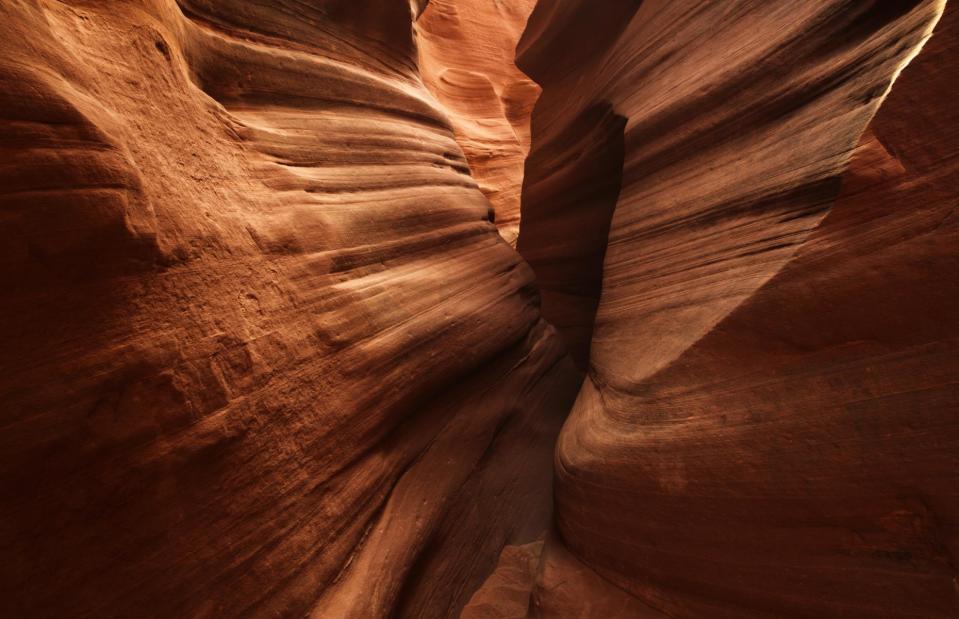
matt train/Shutterstock
Another Utah stunner, Spooky Gulch owes its name to the fact it gets incredibly dark inside its deep slot formations – perfect if you’re searching for thrills. It can be combined with Peek-a-boo Canyon in a 3.5-mile (5.6km) circular hike, starting at Dry Fork Overlook. The best time to visit is spring or autumn, when it’s quieter and the weather is pleasant.
Peekaboo Canyon, near Kanab, Utah, USA

David Swindler/Kane County Office of Tourism
Head around 11 miles (18km) north of the city of Kanab (off US89) and you’ll come to yet another canyon with a familiar name. This Peekaboo (also called Red Canyon Slot) is more accessible than many others – once you’ve driven along the sandy road that leads to the entrance in a 4WD vehicle, that is. The 0.7-mile (1.1km) trail is ever narrowing but mostly flat, with only a few rocky moments. The ambience created by the red rocks is staggeringly beautiful, allowing for stunning light-filled pictures. Arrange a guided walk with local specialists Forever Adventure Tours.
Copper Canyon, Mexico
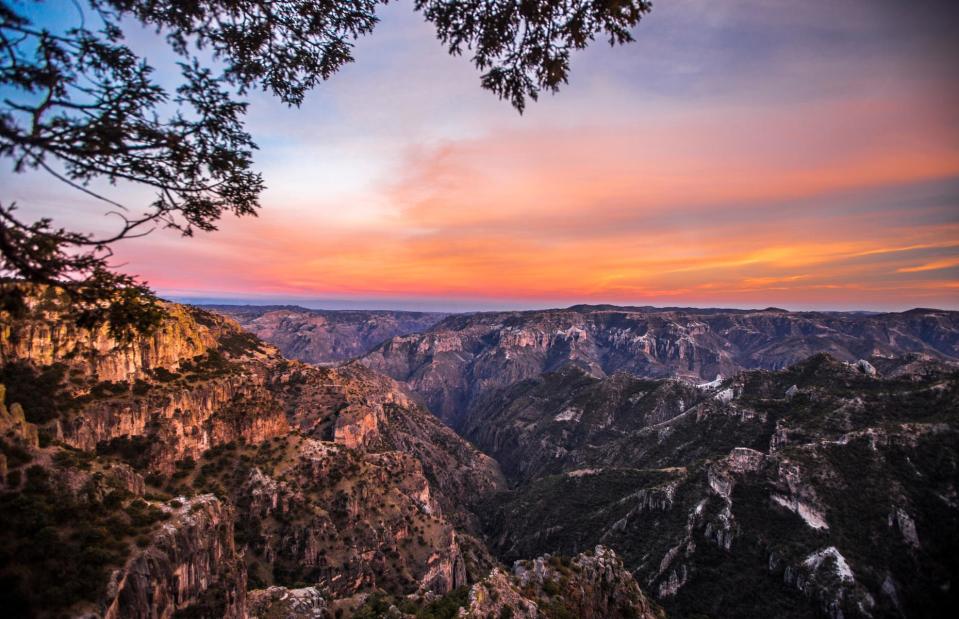
Isabellaphotography/Shutterstock
The rugged, verdant slopes of Mexico’s Copper Canyon, situated in the Sierra Madre Occidental mountains, make for a spectacular sight. The only question is, how to take it all in? A popular option is to board El Chepe, a train which takes a 220-mile (350km) journey between the city of Los Mochis on the west coast to the magical town (pueblo magico) of Creel, offering views of the canyon as it travels through the state of Chihuahua.
Kali Gandaki Gorge, Nepal

Thomas Dutor/Shutterstock
There’s something rather mystical about Kali Gandaki Gorge, the Himalayan canyon which separates the mountains of Dhaulagiri and Annapurna. It’s no wonder then, that the nearly 20,000-foot-deep (6,000m) gorge owes its name to the Hindu goddess Kali, known to embody the power of nature. The best time to visit is between October and December, when skies are clearest. Avoid visiting between May and September – during Nepal’s rainy season.
Echidna Chasm, Western Australia, Australia

Philip Schubert/Shutterstock
A steep and narrow gorge, as tall as 656 feet (200m) and just three feet (1m) wide in places, Echidna Chasm is a sight to behold, especially when the sunlight pierces down between the red rock. The canyon, located in Purnululu National Park in northwest Australia, can be seen via a short 1.2-mile (2km) return walk from the Echidna Chasm car park, although those wishing for a longer hike can continue on to see Mini Palms Gorge.
Witches Gulch, Wisconsin, USA

K Hanley/CHDPhoto/Shutterstock
The most distinctive thing about Witches Gulch, located in the Dells of the Wisconsin River, is the dramatic, undulating shape of the rock walls. It’s thought that they owe their formation to the last ice age, when Wisconsin’s glacial lake broke free from its dam and flooded outwards to create the steep-sided gorge. Nowadays, it can only be accessed via a boat tour, with the warmer months of April to September being the best time to visit.
Grand Canyon, Arizona, USA
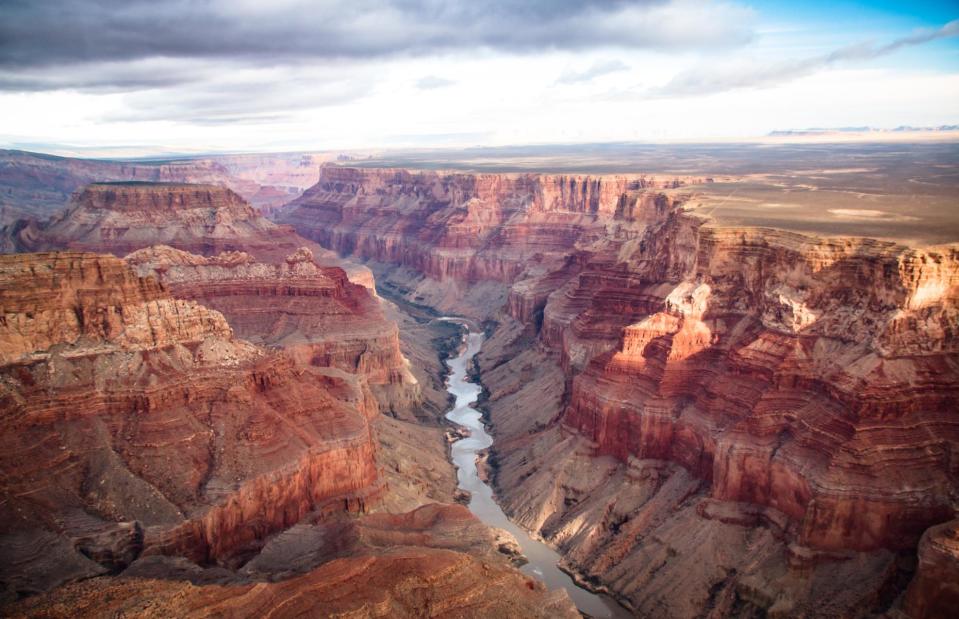
Amanda Mohler/Shutterstock
The world’s largest and best-known canyon needs little introduction. This 6,000-foot-deep (1,828m), 277-mile-long (446km) canyon in northern Arizona has fascinated generations of visitors with its striking red rocks sliced apart with labyrinthine gorges. Even though it attracts around five million people each year, it’s still possible to beat the crowds. Try going to the lesser-known North Rim, visiting at sunrise or during the quieter seasons of spring and autumn.
Verdon Gorge, France

Richard Semik/Shutterstock
Verdon Gorge derives its name from the French word for green and it’s not hard to see why. The limestone canyon opens out to reveal the startlingly bright, emerald waters of the Verdon river below, easily one of the region’s most memorable features. A popular spot for a host of activities – from rafting and kayaking to hiking and climbing – the gorge is ideally located in central Provence, a two-and-a-half-hour drive from Nice or a two-hour drive from Cannes.
Colca Canyon, Peru

sunsinger/Shutterstock
Far from the crowds of Peru’s Inca Trail, quieter Colca Canyon gives the tourist hotspot a run for its money when it comes to picture-perfect views and challenging trails. Located 130 miles (209km) from the southern city of Arequipa, the canyon is surrounded by the stunning Andean mountains and is up to 10,730 feet (3,270m) deep at points, making it one of the deepest in the world. There are numerous ways to check it out, ranging from a one-day tour to a three-day trek.
Waimea Canyon, Hawaii, USA

MNStudio/Shutterstock
If you’re visiting Hawaii, Waimea Canyon is not to be missed. Around 14 miles (23km) long and up to 3,600 feet (1,097m) deep, the gorge stretches along western Kauai, slicing through the Puu Ka Pele Forest Reserve to the west and the Na Pali-Kona Forest Reserve to the east. The scenic canyon was formed by the collapse of a volcano around four million years ago, gaining its reddish blotches from erosion of the exposed basalt. You can visit by car, driving to Waimea Canyon or Puu Hina Hina lookouts or hike one of the canyon’s many trails.
Al Siq, Jordan

Usoltceva Anastasiia/Shutterstock
Combining a treasure trove of ancient culture with a narrow slot canyon, Al Siq offers a magical experience. Serving as the gateway to the ancient city of Petra, the short 0.7-mile (1.2km) gorge starts from the Dam and ends at the Treasury. Don’t rush through it or you’ll miss historical features like the carving of a camel on the wall or remnants of the 2,000-year-old pipes that used to supply Petra with water. It’s best to go early in the morning if you want to beat the crowds.
Buckskin Gulch, Utah and Arizona, USA

kojihirano/Shutterstock
Another jaw-dropping slot canyon on the border between Utah and Arizona, the moody Buckskin Gulch is perfect if you’re looking for a challenging hike. The 20-mile-long (32km) route has plenty of obstacles, including boulders to scramble over and potholes to swim through. It can be completed year-round, but you'll need a permit and during the colder months it’s advisable to wear a wetsuit as the water can get chilly.
Weano Gorge, Western Australia, Australia

Janelle Lugge/Shutterstock
The luminous ridges and glowing pools of Western Australia’s Weano Gorge certainly have an otherworldly feel. Located in Karijini National Park, the gorge was formed over two million years ago by ancient rivers cutting through the layers of iron, dolomite and shale rock, creating the banded appearance. It can be visited via a short loop trail through Lower Weano Gorge down to Handrail Pool and back, or with a longer walk through Upper Weano Gorge. The former is a fairly easy option, though gets more challenging on the way down to the pool.
Taroko Gorge, Taiwan

ThePonAek/Shutterstock
A trip to Taiwan would not be complete without visiting the breathtaking Taroko Gorge, a three-hour drive or a short flight from the capital Taipei. Situated in the Taroko National Park, it’s a hiker’s heaven, with myriad trails weaving between the dramatic marble walls and through tunnels and caves. If trekking isn't your thing, there are plenty of bus tours that go through the national park, which stop at the gorge and other key locations.
Samaria Gorge, Greece

proslgn/Shutterstock
This rugged and rocky canyon can be viewed from a varied, 10-mile (16km) hiking trail, during which you’ll wade through shallow, crystal-clear waters and ascend to sweeping views of the White Mountains. Located near the village of Samaria in western Crete, it’s a must-see if you’re visiting the island – just be sure to pack sturdy hiking boots, as the floor of the gorge is covered in small rocks. Avoid visiting in the height of summer, when hot temperatures can make hiking difficult.
Subway Canyon, Utah, USA

Galyna Andrushko/Shutterstock
The Subway, a short yet spectacular section of the Left Fork of North Creek, takes its name from its tube-like structure, formed by a lava flow which pushed through the rock. Adventurous types can see it by scrambling, wading and swimming down the canyon, starting at Wildcat Canyon Trailhead and finishing at the Left Fork Trailhead, about 9.5 miles (15km) in total. However, you’ll need to apply for a permit in order to get access (awarded via daily and seasonal lotteries), as the route is very popular.
Yarlung Tsangpo Grand Canyon, China

Wikimedia Commons/Public Domain
Yarlung Tsangpo is the world’s deepest canyon, regarded as a haven for biodiversity and famed for its rich geological history. Also known for its perilous waters, the Yarlung Tsangpo River has been nicknamed the Everest of Rivers for its challenging conditions. While parts of the canyon are becoming more accessible as tourism begins to grow in the area, many parts remain remote and inaccessible due to rough terrain, unpredictable weather and slippery slopes.
Fjadrargljufur, Iceland

omeovip md/Shutterstock
One of southern Iceland’s many natural beauties, the canyon of Fjadrargljufur was created in the last ice age by the flowing glacial meltwater that carved its way through the rock. The picturesque gorge, which appeared in a Justin Bieber music video in 2015, had to be closed for a short time in 2019 to recover from overtourism, but has remained open since. If planning a visit, avoid winter when ice and snow make the paths slippery and icy – aim for summer or early autumn, and remember to stick to the trail to avoid trampling on delicate vegetation.
Blyde River Canyon, South Africa

Neil Burton/Shutterstock
Blyde River Canyon, located in the north of South Africa, wows visitors with its lush green slopes, rocky pools and diverse range of wildlife. The 31-mile-long (50km) canyon is thought to have been the point at which an ancient supercontinent called Gondwana split apart some 200 million years ago. Base yourself at the village of Graskop, from which the canyon is easily accessible by road, then try out one of the region’s many hiking trails or indulge your adventurous side with some white-water rafting.
Zebra Slot Canyon, Utah, USA

sumikophoto/Shutterstock
Not a fan of small spaces? Then maybe give this one a miss. The striking Zebra Slot Canyon near Escalante is just 10 inches (25cm) wide in some sections – many hikers turn back before getting through it all. If you’re up for a challenge though, you can hike it by starting at the trailhead on Hole-in-the-Rock Road before descending into Harris Wash, where you’ll find the mouth of the canyon. The canyon itself is only 300 feet long (91m), but it's very difficult to pass through at times.
Tiger Leaping Gorge, China

javarman/Shutterstock
With its piercing blue waters and atmospheric rocky cliffs, Tiger Leaping Gorge attracts many visitors, and while it’s well-served by footpaths, it still retains a sense of wild, untamed nature. The 15-mile-long (24km), 12,800-foot-deep (3,900m) gorge separates Haba Snow Mountain and Jade Dragon Snow Mountain. However, it wouldn’t still be here if it weren’t for the opposition of Indigenous Naxi people and environmental activists, who shut down the Chinese government’s plans to include the gorge in the Three Gorges Dam back in 2007.
Arizona Hot Springs, Arizona, USA

Beth Schroeder/Shutterstock
If you like something a bit more relaxing, Arizona Hot Springs is for you. Located in Lake Mead National Recreation Area, the springs can be reached by hiking for about three miles (4.8km) through a colourful canyon and climbing up a small ladder at the end. The springs are heated by volcanic rocks situated at the intersection of two faults and discharge water at a rate of 30 gallons (136 litres) a minute with a temperature of 44ºC (111ºF).
Itaimbezinho Canyon, Brazil
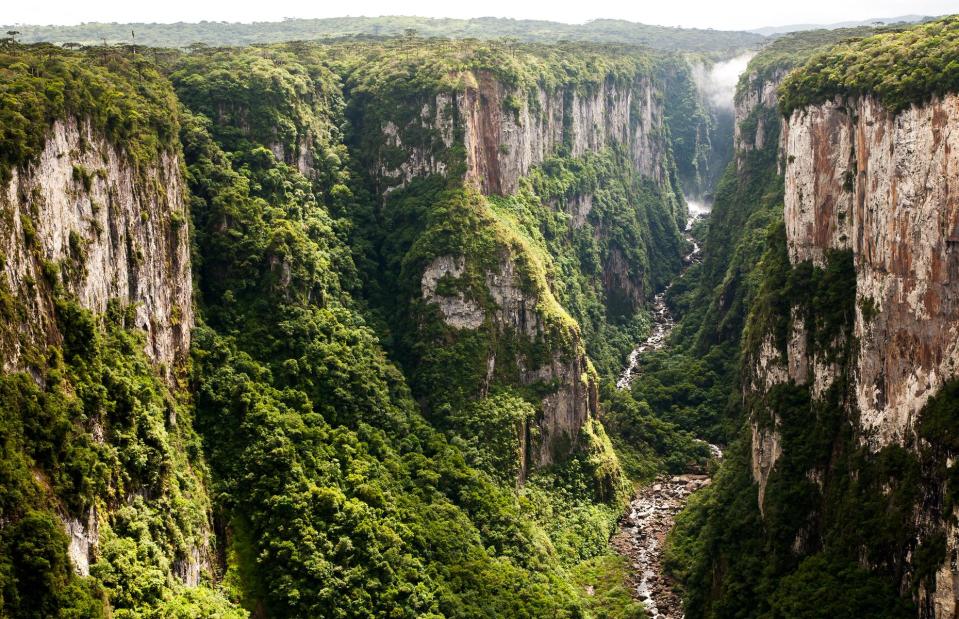
Tacio Philip Sansonovski/Shutterstock
An impressive rock formation that has existed for at least 130 million years, Itaimbezinho’s steep, rocky walls are softened by native pines which give the landscape its lush, green appearance. Located in Aparados da Serra National Park near Porto Alegre, there are two main trails for visitors – the Trilha do Vertice, which takes about an hour to complete, and the Cotovelo, a four-mile (6.3km) trail. It’s best to visit during the region’s winter months, between May and August, when it’s clearer.
Antelope Canyon, Arizona, USA

canadastock/Shutterstock
Surely one of the most picture-perfect slot canyons in the world, Antelope Canyon is recognisable for its swirling sandstone walls, which form a cavernous and narrow path through it. Consisting of two separate sections, Upper and Lower Antelope Canyon, both are the most impressive in the early hours of the morning and in late afternoon, when the red rock is most vibrant. However, visit in the middle of the day and you’ll be greeted with ethereal shafts of light piercing through. The canyon can only be visited on a guided tour as it's located within the Navajo Nation.
Charyn Canyon, Kazakhstan
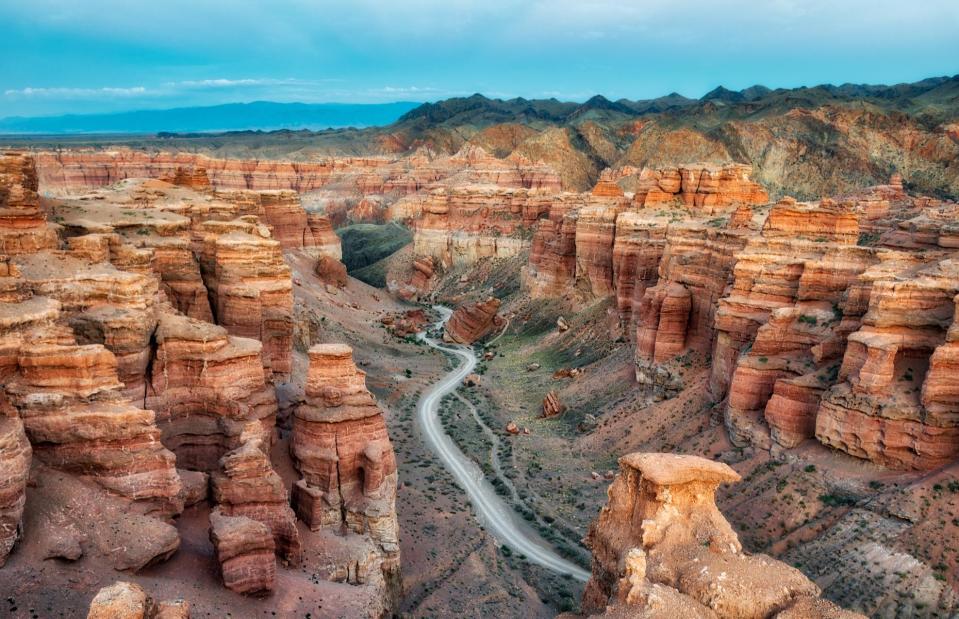
Lukas Bischoff Photograph/Shutterstock
In Charyn Canyon, located between the desert-like landscapes of Altyn Emel National Park and the Tien Shan mountains, wind and water erosion have created impressive, colourful rock formations that showcase Kazakhstan’s breathtaking natural beauty. The 56-mile-long (90km), up to 980-foot-deep (277m) canyon is roughly a three-hour drive from the capital Almaty, so it can be accessed during a long day trip, but it’s better to stay overnight. Visit in spring or summer, as winter can bring dangerously icy conditions.
The Wave, Arizona, USA

Francesco Conti/Shutterstock
There’s an otherworldly feel to The Wave, with its soft, billowing curves and bands of coloured rock – it’s almost like looking into an optical illusion. That means hiking permits are hard to come by and are awarded through either a daily lottery or advanced lottery, if you're planning four months ahead. To up your chances, apply for the quieter months from December through February.
Horseshoe Bend, Arizona, USA

LucasHeplerPhotography/Shutterstock
Seen from above, Horseshoe Bend near Page looks as though someone’s taken a giant horseshoe and stamped it into the Earth. While that may not be the case – the real reason for its U-shaped curve is the winding course of the Colorado River – it’s no surprise it’s a popular photo spot for visitors. Located five miles (8km) downstream from Glen Canyon Dam and Lake Powell, don’t miss either if you’re exploring the area.
Now check out the best bucket-list experiences in America...


